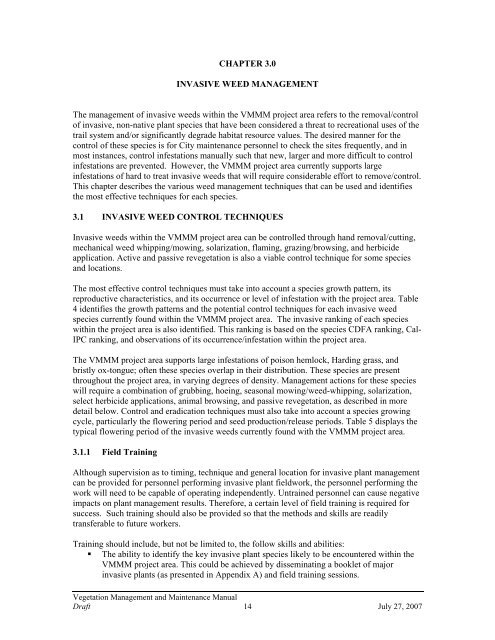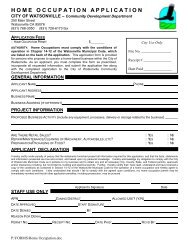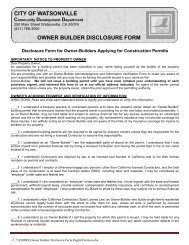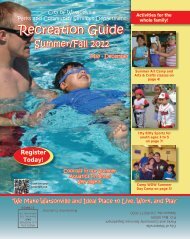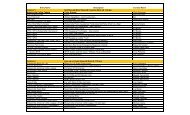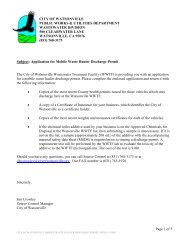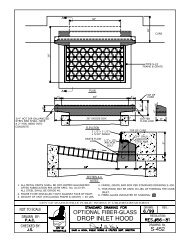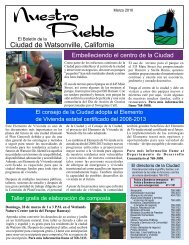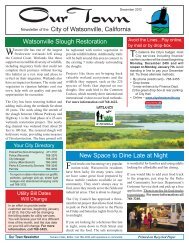Vegetation Management and Maintenance Plan - Watsonville ...
Vegetation Management and Maintenance Plan - Watsonville ...
Vegetation Management and Maintenance Plan - Watsonville ...
You also want an ePaper? Increase the reach of your titles
YUMPU automatically turns print PDFs into web optimized ePapers that Google loves.
CHAPTER 3.0<br />
INVASIVE WEED MANAGEMENT<br />
The management of invasive weeds within the VMMM project area refers to the removal/control<br />
of invasive, non-native plant species that have been considered a threat to recreational uses of the<br />
trail system <strong>and</strong>/or significantly degrade habitat resource values. The desired manner for the<br />
control of these species is for City maintenance personnel to check the sites frequently, <strong>and</strong> in<br />
most instances, control infestations manually such that new, larger <strong>and</strong> more difficult to control<br />
infestations are prevented. However, the VMMM project area currently supports large<br />
infestations of hard to treat invasive weeds that will require considerable effort to remove/control.<br />
This chapter describes the various weed management techniques that can be used <strong>and</strong> identifies<br />
the most effective techniques for each species.<br />
3.1 INVASIVE WEED CONTROL TECHNIQUES<br />
Invasive weeds within the VMMM project area can be controlled through h<strong>and</strong> removal/cutting,<br />
mechanical weed whipping/mowing, solarization, flaming, grazing/browsing, <strong>and</strong> herbicide<br />
application. Active <strong>and</strong> passive revegetation is also a viable control technique for some species<br />
<strong>and</strong> locations.<br />
The most effective control techniques must take into account a species growth pattern, its<br />
reproductive characteristics, <strong>and</strong> its occurrence or level of infestation with the project area. Table<br />
4 identifies the growth patterns <strong>and</strong> the potential control techniques for each invasive weed<br />
species currently found within the VMMM project area. The invasive ranking of each species<br />
within the project area is also identified. This ranking is based on the species CDFA ranking, Cal-<br />
IPC ranking, <strong>and</strong> observations of its occurrence/infestation within the project area.<br />
The VMMM project area supports large infestations of poison hemlock, Harding grass, <strong>and</strong><br />
bristly ox-tongue; often these species overlap in their distribution. These species are present<br />
throughout the project area, in varying degrees of density. <strong>Management</strong> actions for these species<br />
will require a combination of grubbing, hoeing, seasonal mowing/weed-whipping, solarization,<br />
select herbicide applications, animal browsing, <strong>and</strong> passive revegetation, as described in more<br />
detail below. Control <strong>and</strong> eradication techniques must also take into account a species growing<br />
cycle, particularly the flowering period <strong>and</strong> seed production/release periods. Table 5 displays the<br />
typical flowering period of the invasive weeds currently found with the VMMM project area.<br />
3.1.1 Field Training<br />
Although supervision as to timing, technique <strong>and</strong> general location for invasive plant management<br />
can be provided for personnel performing invasive plant fieldwork, the personnel performing the<br />
work will need to be capable of operating independently. Untrained personnel can cause negative<br />
impacts on plant management results. Therefore, a certain level of field training is required for<br />
success. Such training should also be provided so that the methods <strong>and</strong> skills are readily<br />
transferable to future workers.<br />
Training should include, but not be limited to, the follow skills <strong>and</strong> abilities:<br />
• The ability to identify the key invasive plant species likely to be encountered within the<br />
VMMM project area. This could be achieved by disseminating a booklet of major<br />
invasive plants (as presented in Appendix A) <strong>and</strong> field training sessions.<br />
<strong>Vegetation</strong> <strong>Management</strong> <strong>and</strong> <strong>Maintenance</strong> Manual<br />
Draft 14 July 27, 2007


